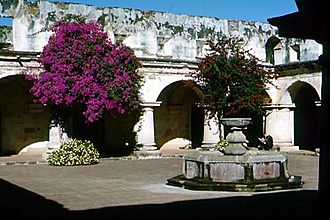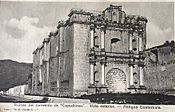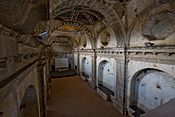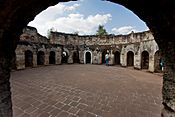Iglesia y Convento de las Capuchinas, Antigua Guatemala facts for kids
Quick facts for kids Convent of the Capuchins |
|
|---|---|
|
Iglesia y convento de las Capuchinas
Convento e Iglesia de Nuestra Señora del Pilar de Zaragoza (Spanish) |
|

Capuchinas monastery
|
|
| General information | |
| Status | Paid access |
| Architectural style | Spanish seismic baroque |
| Location | Antigua Guatemala, |
| Coordinates | 14°33′35″N 90°43′53″W / 14.55972°N 90.73139°W |
| Construction started | 1731 |
| Completed | 1736 |
| Destroyed |
|
| Owner | Consejo Nacional Para la Protección de La Antigua Guatemala |
| Design and construction | |
| Architect | Diego de Porres |
The Iglesia y Convento de las Capuchinas is a famous old building in Antigua Guatemala, Guatemala. It was once a convent and a church. This beautiful place is a great example of how buildings were made in the 1700s. It was officially opened in 1736. However, like many buildings in the city, it was damaged by big earthquakes in 1751 and 1773. After these quakes, the convent was left empty.
History of the Capuchinas Convent
The building was first called "Convent and Church of Our Lady of Zaragoza." King Felipe V approved it in 1725. This was when the Capuchin Order arrived in Santiago de los Caballeros.
Building started in 1731 and finished in 1736. Diego de Porres was in charge of the construction. This was the last convent built in the city. It was also the first one that did not ask for money from new nuns. This meant that poorer women could also join the religious life.
Daily Life of the Nuns
Nuns at the convent followed very strict rules. Some lived a life of poverty and fasting. They were supposed to survive only on donations. In Santiago de los Caballeros, there were two main types of nuns:
- Discalced Nuns: These nuns lived a very strict community life. They did not pay to join the convent. They ate together in silence and could not eat meat. They did all the chores themselves. They wore simple clothes and sandals.
- Urban Nuns: These nuns had a more relaxed life. They paid a donation to join. They lived in larger private rooms, almost like small houses. They could prepare their own food and eat meat. They could also have servants. They wore finer clothes and shoes.
In 1920, Prince Wilhelm of Sweden visited Antigua Guatemala. He found the old Capuchin monastery very interesting. He mentioned its many underground passages. He also noted a special part where the nuns' cells were built in a circle. These cells surrounded a central common room.
Image Gallery
See also
 In Spanish: Iglesia y convento de las Capuchinas (Antigua Guatemala) para niños
In Spanish: Iglesia y convento de las Capuchinas (Antigua Guatemala) para niños





